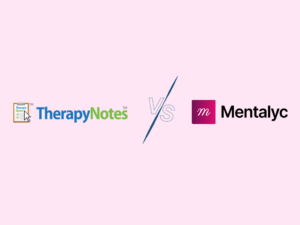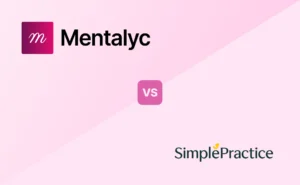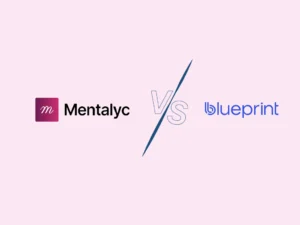As a therapist, your primary focus is to provide adequate care, maintain a strong therapeutic bond, and emotionally support your patients through their difficulties. Chances are, you are a people person. Not a paper person. But for every client you care for comes a duty to keep a chart with well-crafted clinical documentation.
An essential aspect of providing quality mental healthcare is a comprehensive assessment process and documentation of critical information related to the client’s symptoms and diagnosis throughout treatment. Accurate and thorough documentation facilitates communication and coordination among all the professionals in the client’s life related to their mental health care. In addition, it plays a crucial role in the overall patient care process.
In this blog post, we will detail the steps to find an accurate diagnosis, explore the benefits of documenting a patient’s diagnosis and treatment, dive into why this laborious task is so important, and talk about how to make the documentation process easier while also improving the quality and objectivity of the work. (hint: Think of HIPAA-compliant Artificial Intelligence software like Mentalycas your new best friend).
How to Know What Information Is Important when Finding a Mental Health Diagnosis
At the onset of treatment, a psychotherapist initially meets with a new client for a biopsychosocial assessment. This initial meeting typically takes around 1-2 hours to complete. However, it can take longer if information must be gathered from caretakers, family members, and other service providers for a more accurate view.
Spend less time writing, more time with clients.
Automate clinical notes, treatment plans, and progress tracking. Enhance care and stay compliant.

New! Transfer your notes to EHR with a single click. No more copy-pasting.
During this meeting, the therapist’s goals include rapport building and gathering relevant information to make an accurate diagnosis and informed treatment recommendations. The clinician must remember a few things to determine if the information presented is essential to the diagnosis. First, they use their clinical judgment about what might typically be harmful or problematic for someone to experience. Secondly, they observe the client’s affect, body language, and mood, especially as they discuss what they seek help for. Lastly, the therapist looks for hardship or impairment the symptoms are causing in the client’s life.
Typically, an assessment is most efficient in meeting all these goals when a clinician begins the conversation more broadly, such as asking what brought the client to their office first and narrowing down the specificity of questioning as time passes. The clinician tailors the approach depending on the client’s natural way of storytelling and ability to describe their symptoms. As the therapist listens to the client, they look for patterns that begin the 5-Step diagnostic process.
5 Steps to Finding an Accurate Mental Health Diagnosis
Step 1. Symptoms are observed and discussed. Clients often report symptoms when they share their reasons for seeking treatment. Therapist observation is also crucial in gaining initial information regarding the client’s symptoms, as they may not be aware they are exhibiting symptoms. Symptoms clients may be unaware of include but are not limited to mania, psychomotor retardation, and psychosis, such as hallucinations or delusions.
Step 2. Explore differential diagnosis by gathering more pointed information. As the client shares more about their symptoms, patterns will arise that demonstrate whether they are experiencing something similar to a mood disorder, psychosis, trauma response, or another mental health diagnosis category altogether. As the therapist identifies likely diagnoses, they ask questions directly related to the diagnosis they have in mind. They also include questions pertaining to related mental illnesses to rule out differential diagnoses. For example, suppose a therapist is working with a client who reports recently experiencing depressed mood and fatigue. In that case, they ask about other mood disorder symptoms, such as mania and hypomania, to rule out Bipolar I or Bipolar II.
Write less, focus more
Automate notes, treatment plans and progress tracking while keeping your clinical style and the Golden Thread.
- SOAP, DAP, BIRP, EMDR notes and more
- AI Treatment Planner
- AI Progress Tracker
- Alliance signals
- HIPAA & PHIPA compliant
Step 3. Gather More Information from Other Sources. A best practice in mental health diagnosis is gathering information outside of therapist observation and client reports. This can include using symptom report measures such as the PHQ-9,PCL-5, or GAD-7. It also might involve consulting hospital discharge paperwork or speaking to family members, such as parents or caretakers, previous therapists, or a treating psychiatrist.
Step 3. Break Out the DSM 5. By this point, a therapist has an idea of the diagnosis based on the category of symptoms being reported and observed and the symptoms the client has denied experiencing. The therapist looks up the suspected diagnosis and compares the information gathered about the client’s symptoms to the criteria required to meet the diagnosis. This helps the therapist determine if the client meets the criteria or if they should consider other related diagnoses.
Step 4: Document the Diagnosis and Rationale. Use the appropriate codes found in the DSM 5 when writing the formal diagnosis in your clinical documentation. Additionally, clearly write out the symptoms observed and reported, including intensity, frequency, history of symptoms, family history, related patterns of symptoms over time, and the onset of the symptoms. This summary is often found in the last section of the biopsychosocial assessment. It can also include information from the mental status exam and other outcome measures. Lastly, include any differential diagnoses or rule-outs that may still be considered and the rationale for not using these diagnoses.
Benefits of Documenting a Patient’s Diagnosis and Treatment in a Medical Record
Effective documentation of a patient’s diagnosis and treatment in a medical record is vital in providing holistic mental healthcare.
Continuity of Care: Accurate documentation enables other healthcare professionals serving the client to have a comprehensive view of a patient’s mental health treatment with you. As the therapist, you meet with the client most frequently compared to other providers. Because of this and the skill at which you build rapport and trust within the relationship, you can provide other professionals with insight into the client’s symptomatic experience they otherwise might not have access to. This includes previous diagnosis and treatment, embarrassing symptoms the client might not feel comfortable reporting to other providers, and reported non-compliance with medication recommendations. In addition, the information other providers gather from your documentation in the patient’s medical record helps them make informed decisions in their treatment plan.
Enhanced Communication: Clinical documentation allows healthcare professionals to communicate critical patient information across disciplines and healthcare settings effectively. This improves coordination of care, reduces errors, and promotes a holistic approach to treatment, resulting in better client outcomes.
Legal and Ethical Considerations: Documenting a patient’s diagnosis and treatment is essential for legal and ethical reasons. It provides evidence of the care provided, supports decision-making, and helps protect mental health professionals and the organizations they work in when legal disputes or malpractice claims arise.
Maintaining Objectivity: Therapy is a deeply personal process for the client and the therapist. As humans, it is normal for psychotherapists to have their own feelings and opinions arise during a session. However, it is imperative to maintain professional boundaries at all times. Clinical documentation helps therapists take a step back after each season, reflect on the interaction, and record it in a language that focuses on behavior, deeper meaning, and observed patterns from client reports rather than simply how they feel about them. This objectivity allows for more informed, thoughtful decision-making processes related to interventions we choose, treatment recommendations, and potential referrals.
Reimbursement and Legal Compliance: Proper clinical documentation is necessary for accurate coding, billing, and insurance reimbursement processes. Often, insurances require mental health patients to meet ‘medical necessity’ to cover their psychotherapy services. This means a mental health clinician must document not only the symptoms the client is experiencing but also the life impairments that those symptoms are causing, as well as the client’s diagnosis, which is an amalgamation of the previously mentioned impairments and symptoms. In addition, effective clinical documentation ensures compliance with legal and regulatory requirements, is mandatory and helpful during audits, and reduces the risk of fraud.
There are many benefits to thoroughly documenting a client’s diagnosis, including the thought process behind the diagnosis. These benefits protect the patient, the practitioner, and the organization where the services are being provided. However, for the most effective results, it’s wise to remember some best practice tips for symptom and diagnosis documentation.
4 Important Points for Documenting Mental Health Symptoms & Diagnosis
When documenting client information about symptoms and diagnosis in mental healthcare, it is crucial to focus on the following key points:
- Accuracy: All information recorded in the client’s chart should be from the client’s report or directly observed by the therapist. Additionally, all information should be precise, complete, and reflective of the patient’s condition, symptoms, and treatment using objective language.
- Timeliness: Complete clinical documentation as close to the time and date of the mental health service or client contact as possible. Therapists LOVE to procrastinate on their progress notes, but this puts them at risk of losing objectivity and accuracy around what happened during the session.
- Clarity and Organization: Use concise language that any busy healthcare provider can glance at and easily understand. Organize information in a structured manner, including…
- Identifying the symptom
- Symptom frequency
- Patterns of occurrence, such as at night or when the client is stressed
- Symptom Intensity, which is frequently described using the terms ‘severe,’ ‘moderate,’ or ‘mild.’
- Privacy and Confidentiality: Adhere to strict patient privacy regulations, such as the Health Insurance Portability and Accountability Act (HIPAA). Follow best practices to protect patient information and store notes securely.
Other important information to include is the onset of the symptom and any precipitating event that led to this experience.
As any therapist walks down the path of creating thoughtful documentation about diagnostic decision-making, it’s not uncommon to be overwhelmed. Fortunately, there’s an affordable resource to make it easier.
Mentalyc Makes Clinical Documentation Better, Faster, and Easier
Mentalyc, a HIPAA-compliant psychotherapy note software that uses artificial intelligence (AI), works by listening in on session discussions. When the session ends, the software generates a progress note based on identifying the key pieces of information it has been methodically trained to pick up on—no emotion from the software. Instead, just years of scientific research went into developing the algorithms that help it know what to listen for.
When reviewing this note, the clinician can look at the symptoms reported from a different perspective. The AI-generated note may help the clinician look at the information in a new way, identify questions they forgot to ask, or see the client’s report more objectively. AI makes finding and documenting accurate diagnoses faster, easier, and more objective.
Final Thoughts
A mental health diagnosis is one of the most emotionally-laden labels a person can ever receive. This diagnosis will undoubtedly have long-term consequences for the client’s life and treatment. Therefore, the diagnostic process must be conducted objectively and thoroughly for an accurate result. Likewise, the clinical documentation, which will also follow the client, of this process must be completed with the utmost attention and respect. AI note-writing software is an integral tool for therapists to serve their clients in treatment and beyond, accurately assessing and documenting key components of symptoms and diagnosis, informing treatment plans and interventions, protecting therapists from liability, and saving them time in the process.
Disclaimer
All examples of mental health documentation are fictional and for informational purposes only.
Ready to start your free trial?
15 free notes for 14 days • No credit card required
Why other mental health professionals love Mentalyc

“A lot of my clients love the functionality where I can send them a summary of what we addressed during the session, and they find it very helpful and enlightening.”
Therapist

“By the end of the day, usually by the end of the session, I have my documentation done. I have a thorough, comprehensive note … It’s just saving me hours every week.”
CDCII

“Having Mentalyc take away some of the work from me has allowed me to be more present when I’m in session with clients … it took a lot of pressure off.”
LPC

“It’s so quick and easy to do notes now … I used to stay late two hours to finish my notes. Now it’s a breeze.”
Licensed Professional Counselor
Compliant notes. Stronger care.
Automated notes, treatment plans, and insights that prove therapy works.
Try Mentalyc for FREE- How to Know What Information Is Important when Finding a Mental Health Diagnosis
- Benefits of Documenting a Patient’s Diagnosis and Treatment in a Medical Record
- 4 Important Points for Documenting Mental Health Symptoms & Diagnosis
- Mentalyc Makes Clinical Documentation Better, Faster, and Easier
- Final Thoughts
Your Author
Ann Dypiangco, LCSW is a mental health therapist and tech enthusiast who specializes in perinatal mental health and trauma.
With a master’s degree from Boston College, Ann has extensive training in psycho-sensory techniques such as EMDR and Havening. She is licensed in California and runs a small virtual practice.
Ann is passionate about the intersection of technology and mental health and is excited about how AI and the metaverse will transform the industry.
More related posts
-
Some EHRs are trying to ride the AI wave by adding note-taking features, but are they getting it right? We took a closer look at TherapyFuel by TherapyNotes and compared it with Mentalyc, a platform built specifically for insurance-ready therapy documentation. Who nails it, and who’s just pretending? In this comparison of Mentalyc vs TherapyFuel, […]
 Maria Szandrach, CEO of Mentalyc
Maria Szandrach, CEO of Mentalyc -
Mentalyc vs Note Taker by Simple Practice: Features, Pricing & Detailed Comparison AI is sneaking into EHRs these days, so we had to take a closer look. We checked out Note Taker, the AI add-on built right into a Simple Practice EHR, and compared it to Mentalyc, a tool made specifically for therapy notes. This […]
 Maria Szandrach, CEO of Mentalyc
Maria Szandrach, CEO of Mentalyc -
Mentalyc vs Blueprint: Feature, Price, Key Comparison Helping others is your mission – your time is valuable, and your work deserves the right tools. We’ve broken down the strengths and weaknesses of two top AI platforms – Mentalyc vs Blueprint – to help you choose the one that aligns with your values and helps you […]
 Maria Szandrach, CEO of Mentalyc
Maria Szandrach, CEO of Mentalyc






